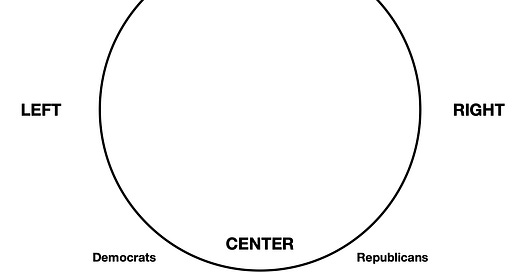'Everyone I don't like is literally Hitler'
Chapter 5.9: Bending a lame spectrum into a circle doesn't make it any less lame
Why this book | Title Page | Table of Contents
Preface | Introduction
PART 1
Chapter 1 (1.1) (1.2) | Chapter 2 (2.1) (2.2) (2.3) | Chapter 3 (3.1) (3.2) (3.3) (3.4) (3.5) (3.6)
PART 2
Chapter 4 (4.1) (4.2) (4.3) (4.4) (4.5) | Chapter 5 (5.1) (5.2) (5.3) (5.4) (5.5) (5.6) (5.7) (5.8) (5.9) | Chapter 6
PART 3
Chapter 7 | Chapter 8 | Chapter 9 | Chapter 10 | Chapter 11 | Chapter 12 | Chapter 13 | Chapter 14
PART 4
Chapter 15 | Chapter 16 | Chapter 17 |
PART 5
Chapter 18 | Chapter 19 | Chapter 20 | Conclusion
Appendix | Works Cited
5.9
Circle spectrums
—I’m Good and you’re not.
Circle Spectrums
And the centrists who love them…
The Marxist continuum has wormed its way so far into our culture that even when people make attempts to create more sophisticated spectrums, they use the assumptions of the Marxist continuum as a baseline. Among the more pernicious of these are spectrums that bend the Marxist continuum into an omega or a nearly closed circle.
The basic form remains the same, with some form of oppression at either extreme. But by bending the spectrum, the two extremes can be placed near each other to indicate their related nature as variants of tyranny. The most recent version I saw labeled that locus of tyrannical confluence as the “lunatic fringe.”
Like the straight-line version, this spectrum has no unit of measure. Or, at best, the unit is less tyranny in the middle, more as you move in either direction away from the middle. But if that is the case, why not just have a continuum that measures degree of tyranny along a continuum, from a theoretical minimum (minarchy or intentional anarchy) to a theoretical maximum (totalitarianism). Why bother with all the circular froufrou?
We know why. For the left, this spectrum serves the same prejudicial purpose as its straight-line variant.
But there is another group for whom this version has a special appeal: centrists. If the far end of either side is the “lunatic fringe,” then the closer you are to the center, the saner you must be. Any step in either direction is one step closer to crazy. For the centrist, this version of the spectrum has a unique prejudicial value: the more politically moderate a person deems himself to be, the easier it becomes to see everyone else, in either direction, as extreme and dangerous. Being a moderate thus becomes a virtue. (We will be discussing the phenomenon of virtue and narcissism shortly, and elsewhere in this work.)
Of course, the late Barry Goldwater whacked back in his famous dictum that, “Extremism in the defense of liberty is no vice. And…moderation in the pursuit of justice is no virtue.”
Glibness aside, the point here is not to whack back at anyone, but to note that by endorsing this circular version, centrists have helped to perpetuate the Marxist continuum’s corrosive impact on politics and history. The Marxist continuum, whether straight or bent into a circle, is not an attempt at political science. It is a weapon of political war.
In addition to that, and to all the flaws we have thus far enumerated, it has another catastrophic failing: it does not have a place on it for genuine classical liberalism.
Classical liberalism carries with it a set of philosophical principles, none of which are satisfied by being placed on a spectrum at the midpoint between one form of oppression and another. Ayn Rand made this point crystal clear in Capitalism: The Unknown Ideal:
To keep reading, and to support my efforts on behalf of human liberty, upgrade here.
Special note: subscriptions are 50% off for the rest of today and tomorrow!
Keep reading with a 7-day free trial
Subscribe to The Freedom Scale to keep reading this post and get 7 days of free access to the full post archives.




